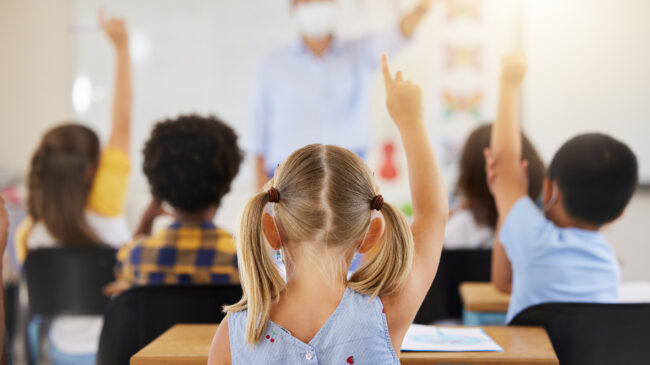While 16 states now have robust open enrollment programs which let students enroll in schools other than their residentially assigned one, fewer states require school districts to share individual services, such as sports or clubs, and courses with students who live outside the district’s boundaries.
According to a new report from Lily Landry and Sam Niederholzer of yes. every. kid. a nonprofit that supports school choice, only eight states—Arkansas, Florida, Idaho, Iowa, Kansas, Minnesota, Utah, and Wisconsin—currently allow students to enroll in individual courses, like Advanced Placement, honors, music, or art classes, at public schools other than their assigned one. And only six states—Arizona, Florida, Idaho, Minnesota, Ohio, and Wisconsin—require public schools to share their services, such as extracurricular or sports activities, with other public schools.
Landry and Niederholzer recommend that state policymakers make it mandatory for school districts to make all courses and activities accessible to all students. Lawmakers should explicitly define the requirements in state statute and not rely on school district discretion so protectionist school districts cannot game the system to exclude students who live outside of a school or district’s boundaries.
The need for flexible learning options, such as making individual courses at public schools available to all students, is highlighted by the ongoing struggle of many kids to recover from the long-term effects of school closures during the COVID-19 pandemic.
A new NWEA brief found that most students’ academic progress continued to stall in the 2022-23 school year, with the average student needing more than four months of extra schooling to catch up with pre-pandemic growth in math and reading. The pandemic especially affected rising ninth graders, as researchers estimate they need an additional year of schooling to make up for losses.
This disheartening data illustrates the need to provide students with flexible learning options so they can find the schools and courses that can help them get back on track. While some school districts have explored unconventional partnerships to help students learn, few states let public school students tailor their educations to fit their individual needs.
During the pandemic, students got the short end of the stick. Schools closed for months. Teacher unions used the pandemic and school reopening negotiations to advocate for additional funding and things like smaller class sizes, increases in non-teaching staff, and suspensions of student and teacher evaluations during the pandemic. Those things should take a backseat because policymakers must prioritize programs that can make learning flexible and help students get back on track.
From the states
School Choice expands in Ohio but flatlines in Pennsylvania.
Pennsylvania Gov. Josh Shapiro announced that he would line-item veto the $100 million voucher proposal in the state budget. Initially supportive of the school choice program, Gov. Shapiro reversed course after Democratic legislators refused to support it.
In Ohio, Gov. Mike DeWine signed the state’s budget into law, expanding the state’s voucher program. Families making up to 450% of the federal poverty line are now eligible for vouchers. Additionally, the new budget increased the voucher’s value by 12%, giving recipients in grades K-8 approximately $6,200 and recipients in high school $8,400.
What to watch
Tennessee residents support more school choice. New polling from Tennessee’s Beacon Center, a free market policy group, found nearly 70% of 1,120 respondents either “strongly supported” or “somewhat strongly” expanding the state’s education savings accounts (ESA) pilot program. These accounts are currently available to students in Hamilton and Knox counties who previously attended public schools identified as performing in the lowest 10%. ESA recipients’ families’ incomes cannot exceed double the “federal income eligibility guidelines for free lunch,” The Center Square reported.
Iowa ESA applicants more than double projected estimates. When policymakers signed the state’s universal education savings accounts into law last year, they expected approximately 14,000 students would apply to the program. Yet, Gov. Kim Reynolds announced this month that more than 29,000 students had applied.
School choice could have another chance in Texas. Gov. Greg Abbott has promised to call a legislative special session for education. Texas policymakers, however, noted that school choice proposals must include significant accountability measures. “I just don’t see a pathway of public dollars flowing into private education if there’s not accountability,” Republican Rep. Keith Bell said.
Florida’s school choice applications explode. Step Up For Kids’ Scott Kent told Axios that the organization has received almost 177,000 applications for Florida’s tax-credit scholarship and the Family Empowerment Scholarship for Educational Options programs. These applications represent about 245,000 students. Florida passed a law this year making all students, regardless of income, eligible for a voucher of about $8,000 a year.
Recommended Reading
Implementing K–12 Education Savings Accounts
Nicole Stelle Garnett and Mike Q. McShane at Manhattan Institute
“ESA programs are not going to stand up on their own. It is going to take thoughtful management from both the public and private sectors to ensure that the rules, regulations, policies, and procedures drafted to implement the programs reflect the desires and intentions of the legislators who created them. It is going to take innovation in the tech space to create the kinds of platforms that will make navigating the onboarding families and use of ESA dollars seamless and straightforward.”
The 123s of School Choice 2023 Edition
EdChoice Staff at EdChoice
“Almost 190 empirical studies of school choice programs have been published to date; few education reforms have been researched as extensively. Generally, each study provides something different—a different program to study, different ages of the program, and different research methods. Perhaps most notably, these studies look at a variety of outcomes.”
A Poor Poverty Measure
Ishtiaque Fazlul, Cory Koedel, and Eric Parsons at Education Next
“Yet a close look shows that free and reduced-price meal designations in the National School Lunch Program are grossly inaccurate indicators of family income. Using administrative data from Missouri, we find that student enrollment in the program is oversubscribed by about 40 to 50 percent relative to stated income-eligibility rules. This finding is not unique to Missouri. We see the same basic pattern in an extended sample of 27 states. Moreover, this is not a recent phenomenon.”

